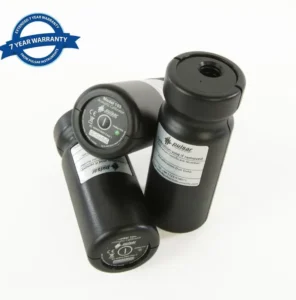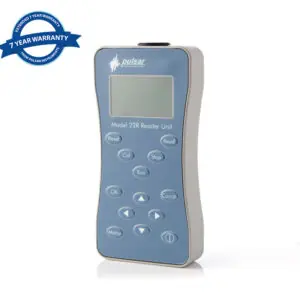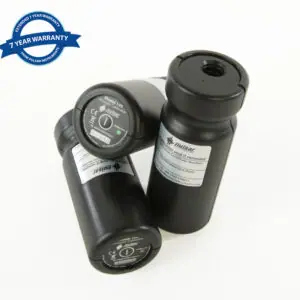Acoustic Calibrators
Dual Level Acoustic Calibrator

To ensure your noise measurements are legally compliant with Noise Regulations you MUST field calibrate your sound level meter before and after taking your measurements; most noise-related regulations stipulate that the noise meter or noise dosemeter is calibrated before each acoustic calibration session and checked again before turning the instrument off. In fact, noise measurements made for ‘official’ use, such as industrial health & safety or environmental monitoring, are not valid unless correct calibration procedures have been followed.
Our dual-level acoustic calibrators are suitable for the field and laboratory calibration of sound level meters, noise dosimeters, and other noise measurement instruments.
The calibrator is simple to operate and meets the requirements of the latest IEC 60942:2017 standard for acoustic calibrators with performance to Class 1 or Class 2 and features both 94dB and 114dB at 1kHz sound pressure level output in one single instrument.
It’s ideal for use with a variety of noise dosimeters, where 94dB or 114dB can be used in preference.
Acoustic Calibrator

Acoustic Calibrator Models 105 (Class 1) and Model 106 (Class 2) have been tested and formally EU Pattern Approved by the PTB (under certificate PTB-1.61.4034842), as meeting all of the requirements of the latest International standard, IEC 60942: 2003 (equivalent to ANSI/ASA S1.40-2006). This version of the IEC international standard is far more stringent than previous versions and so far very few manufacturers have managed to meet it. The two models are intended to field calibrate (that is set the sensitivity), of any properly approved noise meter that uses a standard measurement microphone.
To ensure your noise measurements are legally compliant with Noise Regulations you MUST field calibrate your sound level meter before and after taking your measurements; most noise-related regulations stipulate that the noise meter or noise dosemeter is calibrated before each acoustic calibration session and checked again before turning the instrument off. In fact, noise measurements made for ‘official’ use, such as industrial health & safety or environmental monitoring, are not valid unless correct calibration procedures have been followed.
Both the Models 105 (Class 1 acoustic calibrator) and Model 106 (Class 2 acoustic calibrator) give a standardised 1kHz tone for sound level calibration (calibration level) – the frequency where all weighting networks are the same, at a pressure of 1 Pascal which is a sound level of 94 decibels. They have sensors to correct for temperature, humidity, barometric pressure and battery voltage so that they remain stable and accurate under almost any conditions where they are likely to be used.
- The units are simple to operate and meet the requirements of the latest IEC 60942:2003 standard for Class 1 and Class 2 Calibrators.
- Model 105 sound level calibrator complies fully with Class 1 – the precision class, meeting the requirements of Class 1 sound level meters.
- Model 106 complies fully with Class 2, meeting the requirements for the calibration of industrial Class 2 sound level meters used in almost all Health and Safety applications.
- We have taken great care during the design process to ensure that the units are comfortable to hold, robust and easy to used, whilst performing accurately throughout a wide range of temperature, humidity and pressure conditions.
- The calibrators are powered by an easy-to-access single 9-volt battery giving many months or even years of operation. An automatic shut-off circuit ensures power conservation should you forget to switch off the unit.
Features
- Advanced performance ensures that both models meet or exceed IEC 60942 accuracy requirements
- Full PTB pattern approval awarded on both models
- Ergonomic and robust design ensures comfortable use
- Auto-correction for temperature and barometric pressure
- Auto switch off in normal mode and ‘permanent-on’ mode available
- 94dB Sound Pressure Level
- Fits ½ inch international standard microphones
- ¼ inch adaptor available
- Calibration certificate included
- 12 months’ warranty extendable to 7 years
- Acoustic Calibration of noise meters and dosemeters
Models 105 and 106
Whilst both the Model 105 and Model 106 can be ordered separately, they are most often supplied as part of a noise measurement kit. The Model 105 for a Class 1 noise measurement kit and the Model 106 for a Class 2 noise measurement kit.
Each Sound Level Calibrator is supplied with the following:
- User manual
- Certificate of calibration
- Battery (9V)
- 12 months warranty extendable to 7 years*
* To qualify for the 7-year warranty, you will need to send your Calibrator back to us annually for service and recalibration whereupon the warranty is extended for a further 12 months for up to 7 years.
Dosemeter Reader Unit with Integral Acoustic Calibrator

The Reader and Calibrator Unit for the Pulsar Noise Dosemeter system controls the individual dosemeter badges. The Reader Unit communicates with the dosemeter via an infra-red link.
The Reader Unit is required to calibrate the dosemeters prior to measurement as per the requirements of the Noise at Work Regulations and HSE requirements. Once you have fitted the dosemeter onto a workers shoulder (or helmet using the helmet mount) you are ready to start the dosemeter via the infra-red link. Once the noise exposure measurements have been taken the dosemeter is stopped in the same way using the Reader Unit.
